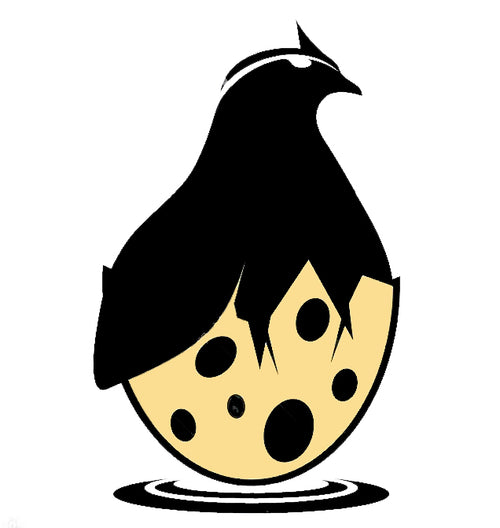Quail Care-From Eggs To Chicks
Egg Hatching:
- Unpack your eggs carefully and search through the packing material for your ‘extra eggs’. We always throw in some extras just in case there’s breakage during shipping.
- Place your eggs ‘pointy side’ down for 6-12 hours to let them settle before placing in the incubator. This ensures the air sac develops at the correct end of the egg. If placing eggs in an incubator tray that allows them to be loaded pointy side down, then you can skip this step.
- You need an INCUBATOR. There’s a lot of them on amazon and some are OK, but most have really bad feedback for their temp/humidity gauges. You ALWAYS need a 3rd party temp/humidity gauge such as ‘govee’ brand ones to confirm your incubator temp/hum. Your temp should be at 99.5% and humidity should be at 45-55% throughout the process. Temp is far more important than humidity and a temp of 96 to 102 will still be OK. Cooler temps mean slower incubation and warmer ones mean faster, but SHOOT for 99-100.5F!
- Your eggs should be turned for best results. This means using an automatic egg turner or turning by hand 3x a day or more. If you don’t use an egg turner your hatch rate will drop a good bit.
- Wait for 14-15 days from the point you put the eggs IN the incubator and you can stop turning them.
- Increase humidity to 65% (no higher than 75% or they WILL drown in the egg!)
- 3 days later you’ll start to see hatchimals popping and chipping away at the egg. They’ll use their egg tooth and saw the top of the egg off and pop out. NEVER HELP A CHICK OUT OF AN EGG UNLESS IT HAS TRIED TO FULLY UNZIP THE SHELL! If you pull them out too early you’ll kill them.
- Give them 24hrs to dry off then you can place them in your brooder.
On shipping eggs we typically see a 50-75% hatch rate. You can check for duds with an incubright egg candler. Note: most candlers do not work well for quail eggs! You may or may not see what’s really happening with low quality ones so do not throw out eggs until 24 days after incubation started. You may get late hatchers.
Brooder Requirements: Young quail chicks are small and delicate and need a proper draft-free brooding setup. Provide .25 square foot per chick of brooder space. Increase the size as they grow. Quail chicks will need a secure surface to walk on for proper leg development. An old terry cloth towel or blue paper towels work well. Newspaper is too slippery. For older chicks, pine shavings are ideal.
Temperature: You will need a heat lamp for your chicks. Start your chicks off at 100 degrees for the first two weeks, which is a bit warmer than your average chick. Raise the heat lamp in order to drop the temperature a few degrees every other day until the internal temperature matches the outside ambient air temp, or they've reached about 4 weeks of age. It's important to watch how your quail chicks respond to the temperature of the lamp; huddling under the bright indicates they're likely cold and huddling in shaded areas away from the heat lamp will indicate they are too warm. Adjust the height as necessary to allow the chicks to be comfortable enough to run freely throughout the brooder space. Keep a thermometer in a lightweight sandwich bag at the bottom of the brooder to monitor the temperature. Note: Quail chicks tend to pile when they sleep at night if they are too cold, and this can lead to crushing of the chicks on the bottom.
Feed: Feed quail chicks a high-quality game bird or turkey starter feed for the first six weeks that contains 24% protein. Transition to a breeder feed at 6-7 weeks and remember to always have feed available to your chicks. For the first few days, place the feed on paper towel next to their feeder so they can find it.
Water: Use a special quail base on your waterer while your chicks are young as they can fall into a standard base and chill or drown. An alternative is to place marbles or pebbles in the drinking troth so that way they don’t drown or get their feathers wet. As soon as you get your chicks into the brooder, immediately dip their beaks in water to teach them how to drink. All quail need to have access to clean drinking water at all times. Warm water is important as cold water can shock and chill the birds.
Juvenile or Adult care: Once quail get feathers on their HEADS you are safe to leave at room or cooler temperatures. Your older quail will not need a brooder or heat lamp.
Housing: There are many housing options for adult quail. People usually raise them either in large open flight pens or cages. It is best not to raise them in the same coop as chickens. Bobwhite quail need about 1 square foot per bird to reduce aggression. Coturnix are more domesticated and do fine with a bit less.
Quail are small and sleep on the ground which makes them susceptible to predation. Flight pens will need to be secure. We recommend 1/2 inch hardware cloth. Provide a solid enclosed area at night to be extra safe. Quail like to run so design cages to be longer rather than wider. They also tend to fly or flush straight up if startled. Designing cages with soft tops (like netting) so they avoid crashing into the hard roof. You could also design your cages to be 2 feet high or less, where the quail won't have the space to build up enough speed to crash and cause harm.



